| Home Page 主頁 |
New Data 最新資料 |
Chronology 歷史編年表 |
HK/Macao 港澳錢幣 |
Cast Coins 中國古錢 |
Struck Coins 機鑄幣 |
Paper Money 紙幣 |
Values/Wants 估值及征購 |
Links/References 網站參考鏈接 |
The most widely circulated coin in China
It is very strange that the conventional type of "Yuan Shih Kai"  coins which were great trusted by the Chinese, and were widely circulated throughout in China in those days. I think those who collect Chinese coins, they must have at least one or two Yuen's coins, because Yuan's coins are very common. But I find that type of coins were seldom talking by any coinage related web site in the world. coins which were great trusted by the Chinese, and were widely circulated throughout in China in those days. I think those who collect Chinese coins, they must have at least one or two Yuen's coins, because Yuan's coins are very common. But I find that type of coins were seldom talking by any coinage related web site in the world.According to the "Regulations of the National Coinage of the Republic" which was announced by the Board of Finance in 1914. The national coins were first minted by the Tientsin Mint in the 3rd year of the Republic (1914), followed by the Wuchang, Nanking, Kwangtung and Hangchow etc., mints. [Chiang Chung Chuan : Illustrations of Chinese gold silver and nickel coins, 1939. P.211] |
|
Note from Standard catalog of World Coins 18th edition P.329
|
Extremely Rare A ~ Very Rare B ~ Rare C ~ Not So Many D ~ Common E
| Obverse | Reverse | Description |
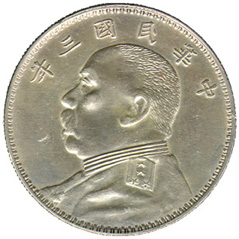 |
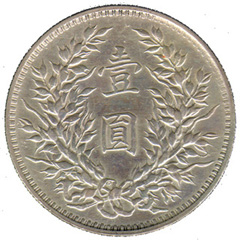 | No. 073 |
| Diam. 38 mm | ||
| Wt. 26.8 g. | ||
| Mint Evolution and Peculiarity | Rareness D | |
| On the obverse of this coin is Yuan Shih-Kai's side-view portrait. Above it there are 6 Chinese characters, means the 3rd year of The Republic of China (1914AD). On the reverse, are 2 Chinese characters, means one dollar within a double good harvest designs. There are many varieties in the writing styles of the year and the mint, this is one of the regular issued. The original design of this coin was engraved by the Italian L. Giorgi. His name was inscripted behind the shoulder of the Yuan's profile in the experimental patterns, but in this coin his name was removed. On the reverse, under the two Chinese character "I Yuan", in the knot, there is a small alphabet "O" which is a mint mark. But I don't know what mint is indicated. According to the coinage definitely specified in the Regulations of 1914 this One-dollar or main coin should be weighing 7.2 maces with 89% silver. |  | |
| Obverse | Reverse | Description |
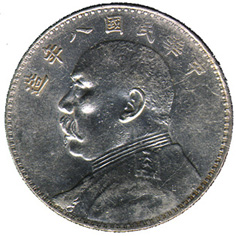 |
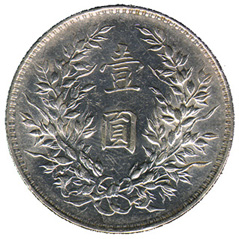 | No. 074 |
| Diam. 38 mm | ||
| Wt. 27 g. | ||
| Mint Evolution and Peculiarity | Rareness D | |
| On the obverse of this coin is Yuan Shih-Kai's profile. Above it there are 7 Chinese characters, means made in the 8th year of The Republic of China (1919AD). This coin is comparatively rare type. Weak strike affects the last three characters and some smoothing appears on high points on the obverse, this causes much reductiion in coin grading. Otherwise this would be a very nice coin. On the reverse, are 2 Chinese characters, means one dollar within a double good harvest designs. Please be noted that it is difficult to get a 8th-years Yuan's coin in better condition.
Additional Informations about 8th Year Yuan's Dollar by
Mr. H Sun
The first 8th year Yuan's dollar was struck by Tientsin Mint, then
Anking and Hangchow mints. Most of the 8th year Yuan's dollars were
minted by Anking and Hangchow. The turnout from Anking in mid 1924 are
said to be reduced fineness from 0.830 to 0.760.
SOMETHING ABOUT ANKING MINT Anking was the capital of Anhwei Province about 400km west by south of Shanghai. The mint at Anking began operation in 1897 and it shut down in 1899. A new mint was opened in 1902 for Cash coins but included a series of silver coins, it later closed again in 1907. Due to the Spanish Carolus & Mexican Eight Reales which were particularly popular in Anhwei Province until about 1920, the idea of replacing foreign coins with local made money began, so the Anking Mint was reopened on Dec. of 1919. The authorities in charge of this mint were concerned with profit making, instead of the community interests, so the quality of its output was lower than the standard --0.890. In the summer of 1924 this fact was detected and widely spread. With the result of a public boycott, the Anking Mint was closed in 1926. ...and HANGCHOW MINT A mint was opened in Chehkiang Province's capital, Hangchow (about 160 km southwest of Shanghai), in 1899, but shortly thereafter it was dismantled and shipped to Peking. Two mints were opened at Hangchow in 1903 and 1905, and they were merged with the Fukien Mint in 1906-07. However, production was resumed in 1919. It was run by a private party until 1921. The mint was very active until 1930. It was closed down during early-1930s. The quantity of dragon silver coins made by Hangchow mint was very small. Both mints were reopened in 1919, and their dies were supplied by Tientsin(Central) Mint, perhaps that's the reason they share the most of these 8th year Yuan's dollars. PLEASE NOTE: ALL MINTS IN CHINA CHANGE NAMES FROM TIME TO TIME. OFFICIAL RECORDS WERE INCOMPLETE. Its my opinion that if someone is interested in machine-made Chinese coins, knowing some historical background of modern China and its mints are very helpful. EVERY PIECE OF MONEY TELLS A STORY! | ||
| Obverse | Reverse | Description |
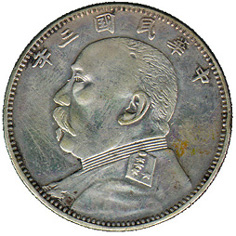 |
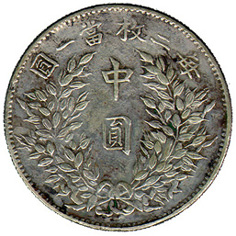 | No. 075 |
| Diam. 31 mm | ||
| Wt. 13.2 g. | ||
| Mint Evolution and Peculiarity | Rareness D | |
| On the reverse side are the words indicating value of 50 cents surrounded by the cross designs of good harvest. Above it there are 6 Chinese characters, means the value of two pieces is equal to one dollor.
According to the Regulations of 1914 regarding the national currencies of the Republic of China, this 50-cent subsidiary coin should be weighing 3.6 maces with 70% silver. | ||
| Obverse | Reverse | Description |
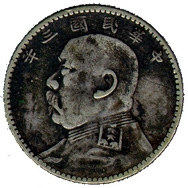 |
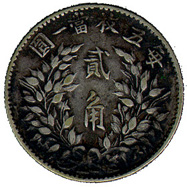 | No. 076 |
| Diam. 22 mm | ||
| Wt. 5.2 g. | ||
| Mint Evolution and Peculiarity | Rareness E | |
|
On the reverse side are the words indicating value of 20 cents surrounded by the cross designs of good harvest. Above it there are 6 Chinese characters, means the value of five pieces is equal to one dollor.
According to the Regulations of 1914 regarding the national currencies of the Republic of China, this 20-cent subsidiary coin, weighing 1.44 maces with 70% silver.
| ||
| Obverse | Reverse | Description |
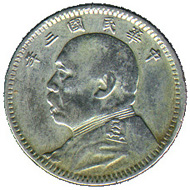 |
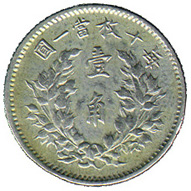 | No. 077 |
| Diam. 18.5 mm | ||
| Wt. 2.7 g. | ||
| Mint Evolution and Peculiarity | Rareness E | |
On the reverse side are the words indicating value of 10 cents surrounded by the cross designs of good harvest. Above it there are 6 Chinese characters, means the value of ten pieces is equal to one dollor. According to the Regulations of 1914 regarding the national currencies of the Republic of China, this 10-cent subsidiary coin, weighing 0.72 maces with 70% silver. | ||
Yuan Shih Kai Silver Dollar
or
More about Yuan Shih Kai Silver Dollar
 , he became a 3rd-grade official in charge of training a modern army at Hsiao-Chan near Tientsin in 1895. Later, he was promoted to the position of assistant minister in charged of military training, as he pretended to support institutional reforms. In 1897, he promoted as the governor of Shantung province, and two years later he was promoted again to be the governor of Chihli province. In 1901 he promoted as the minister of Peiyang, gradually becoming the leader of the Peiyang warlords, as he won the trust of Empress Dowager Szu Hsi. Yuan took part in the suppression of Boxers insurgent in 1900. In 1907, Yuan was summoned to the court to became a grand minister of the Privy Council and Minister of Foreign Affairs. After Dowager Empress died, he was stripped of all his offices in 1909.
, he became a 3rd-grade official in charge of training a modern army at Hsiao-Chan near Tientsin in 1895. Later, he was promoted to the position of assistant minister in charged of military training, as he pretended to support institutional reforms. In 1897, he promoted as the governor of Shantung province, and two years later he was promoted again to be the governor of Chihli province. In 1901 he promoted as the minister of Peiyang, gradually becoming the leader of the Peiyang warlords, as he won the trust of Empress Dowager Szu Hsi. Yuan took part in the suppression of Boxers insurgent in 1900. In 1907, Yuan was summoned to the court to became a grand minister of the Privy Council and Minister of Foreign Affairs. After Dowager Empress died, he was stripped of all his offices in 1909.
 ,
, 1994, p.924 ISBN 7-5000-5469-6.
1994, p.924 ISBN 7-5000-5469-6.  (An Overview of China's Gold & Silver Coins of Past Ages - The gold and silver coins and medals of modern China. p.843 ISBN 962-531-001-0)
(An Overview of China's Gold & Silver Coins of Past Ages - The gold and silver coins and medals of modern China. p.843 ISBN 962-531-001-0)